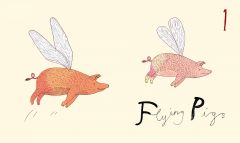![]()
![]()
![]()
Use LEFT and RIGHT arrow keys to navigate between flashcards;
Use UP and DOWN arrow keys to flip the card;
H to show hint;
A reads text to speech;
23 Cards in this Set
- Front
- Back

Piaget’sTheory |
-Children actively constructtheir knowledge -scientific problem solvers |
|
|
Schema: |
-a concept of framework that exist in an individua’s mind to organize and interpret information -social cues |
|
|
Mechanisms of change (3) |
-Assimilation -Accommodation -Equilibration |
|
|
Assimilation |
-Occurs when an individual incorporates new informationinto existing knowledge -child has a schema for cat and they when the see a tiger and call it a cat -Not passive: environmentalinput is often modified to be incorporated into schemas |
|
|
Accommodation (complementary process of assimilation) |
-individuals adjust/adapt theirschemas to new information -making a schema of cats and a schema for tigers |
|
|
Equilibration |
-the process by why which childrenkeep their cognitive structures in balance; achieved through assimilation and accommodation |
|
|
Piaget’s theory; The Stage Model |
-sensorimotor (birth to~2 years), -preoperational (~2 years to 7 years), -concrete,operations (~7 to 12 years), -formaloperations (~12 years onward) |
|
|
sensorimotor (birth to ~2 years), |
-moves fromsimple reflexes to symbolic thought -repetitive behaviors: -modification reflexes: Habits, sucking their thumb - start Object Permanence (conservation of existence) |
|
|
A-not-Berror (sensorimotor) |
-12-18 months (active experimentation) -Put a toy under a blanket then -move it under another blanket. -The babywill still think its under the first one since that’s where they saw it last |
|

Baillargeon (1987) habituation (sensorimotor) |
-participants: 4-1/2-month-olds -Impossible event: thecar and the block -sees a car going down a track, the middleof the track is covered -the baby sees that the car will still come out the other side -then they show the same track with a blockon it then they cover it up with the screen and move the block to let thecar go |
|

preoperational (~2 years to 7 years), |
-use symbols to represent objects |
|

DeLoache’s explanation: Dual representation (preoperational) |
-find snoopy -2½-year-olds don’t tend find him but 3yr olds do -moving the child from being focused ontheir own perspective to becoming more interactive -collective monologue -"do you have a brother" |
|

Conservation (preoperational) |
-coins, water in two different cups -the realization that an entityremains the same despite changes in its form -some kids can understand the difference |
|

Spatial perspective taking (preoperational) |
-They will report what they can see as what the otherwould see -three mountain diagram -most 4yr olds fail it but they can pass if its a more familiar scene |
|
|
concrete, operations (~7 to 12 years), |
-Thinking based on mentaloperations -understand operations performed can be reversed(conservation is possible) -ability to classify objects is qualitatively ( sorting coloured shapes varying in sizes and colours) |
|
|
formal operations (~12 years onward) |
-not considered universal -begin to think about the formof the argument -capable of logical and scientific thinking |
|
|
hypothetical-deductivereasoningions |
-scientific thinking: Beaker problem (test all to find the solution) -Abstract thinking: things that are intangible -Reflective abstraction (reflecting on their own thoughts) |
|
|
Piaget’s Cognitive Stages Theory (5 stages) |
-Qualitative change: -Broad applicability: -Invariant sequence -Brief transition -Universality |
|
|
Qualitative change |
-change from looking at the details to the bigger picture -moral reasoning – outcome-to-intention shift -spilling water accidentally |
|
|
Broad applicability |
-consistency across domains within a stage -all domains in a stage connect |
|
|
Invariant sequence |
-the order of the stages is fixed andstages cannot be skipped -everyone goes through all stages |
|
|
Brief transition |
-transition periods between stages is brief -When there is a shift,it happens quickly. -If it was slow, itwould be qualitative. |
|
|
Universality |
-the first three stages are applied across all cultures |

